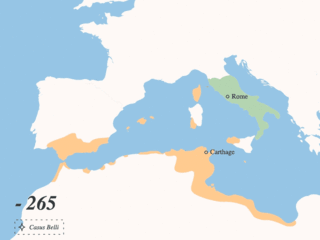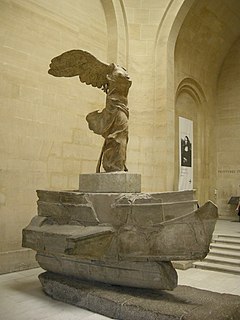Related Research Articles

The First Punic War was the first of three wars fought between Rome and Carthage, the two main powers of the western Mediterranean in the early 3rd century BC. For 23 years, in the longest continuous conflict and greatest naval war of antiquity, the two powers struggled for supremacy. The war was fought primarily on the Mediterranean island of Sicily and its surrounding waters, and also in North Africa. After immense losses on both sides, the Carthaginians were defeated.

The Punic Wars were a series of wars between 264 and 146 BC that were fought between Rome and Carthage. The First Punic War broke out on the island of Sicily in 264 BC. It was regarded as "the longest and most severely contested war in history" by the Ancient Greek historian Polybius. The fighting, which consisted predominantly of naval warfare, largely took place on the waters of the Mediterranean surrounding Sicily. The conflict began because Rome's imperial ambitions had been interfering with Carthage's ownership claims of the island of Sicily. Carthage was the dominant power of the western Mediterranean at the time, and had an extensive maritime empire; meanwhile, Rome was a rapidly expanding state that had a powerful army but a weak navy. The conflict lasted for 23 years and caused substantial materiel and human losses on both sides; the Carthaginians were ultimately defeated by the Romans in 241 BC. By the terms of the peace treaty, Carthage paid large war reparations to Rome and Sicily fell to Roman control—thus becoming the first Roman province. The action of taking control of Sicily had further entrenched Rome's position as a superpower in the Mediterranean and the world as a whole. The end of the war also sparked a significant, but unsuccessful, mutiny and rebellion within the Carthaginian Empire referred to as the Mercenary War.

Naval warfare is combat in and on the sea, the ocean, or any other battlespace involving a major body of water such as a large lake or wide river. Mankind has fought battles on the sea for more than 3,000 years. Even in the interior of large landmasses, transportation before the advent of extensive railroads was largely dependent upon rivers, canals, and other navigable waterways.

The Battle of Sluys, also called the Battle of l'Écluse, was a naval battle fought on 24 June 1340 between England and France. It took place in the roadstead of the port of Sluys, on a since silted-up inlet between Zeeland and West Flanders. The English fleet of 120–150 ships was led by Edward III of England and the 230-strong French fleet by the Breton knight Hugues Quiéret, Admiral of France, and Nicolas Béhuchet, Constable of France. The battle was one of the opening engagements of the Hundred Years' War.

The Battle of the Lipari Islands or Battle of Lipara was a naval encounter fought in 260 BC during the First Punic War. A squadron of 20 Carthaginian ships commanded by Boödes surprised 17 Roman ships under the senior consul for the year Gnaeus Cornelius Scipio in Lipara Harbour. The inexperienced Romans made a poor showing, with all 17 of their ships captured, along with their commander.

The Battle of Cape Ecnomus or Eknomos was a naval battle, fought off southern Sicily, in 256 BC, between the fleets of Carthage and the Roman Republic, during the First Punic War. The Carthaginian fleet was commanded by Hanno and Hamilcar; the Roman fleet jointly by the consuls for the year, Marcus Atilius Regulus and Lucius Manlius Vulso Longus. It resulted in a clear victory for the Romans.
The naval Battle of Drepana took place in 249 BC during the First Punic War near Drepana in western Sicily, between a Carthaginian fleet under Adherbal and a Roman fleet commanded by Publius Claudius Pulcher.
The Battle of the Aegates was a naval battle fought on 10 March 241 BC between the fleets of Carthage and Rome during the First Punic War. It took place among the Aegates Islands, off the western coast of the island of Sicily. The Carthaginians were commanded by Hanno, and the Romans were under the overall authority of Gaius Lutatius Catulus, but Quintus Valerius Falto commanded during the battle. It was the final and deciding battle of the 23-year-long First Punic War.

From the 4th century BC on, new types of oared warships appeared in the Mediterranean Sea, superseding the trireme and transforming naval warfare. Ships became increasingly large and heavy, including some of the largest wooden ships hitherto constructed. These developments were spearheaded in the Hellenistic Near East, but also to a large extent shared by the naval powers of the Western Mediterranean, specifically Carthage and the Roman Republic. While the wealthy successor kingdoms in the East built huge warships ("polyremes"), Carthage and Rome, in the intense naval antagonism during the Punic Wars, relied mostly on medium-sized vessels. At the same time, smaller naval powers employed an array of small and fast craft, which were also used by the ubiquitous pirates. Following the establishment of complete Roman hegemony in the Mediterranean after the Battle of Actium, the nascent Roman Empire faced no major naval threats. In the 1st century AD, the larger warships were retained only as flagships and were gradually supplanted by the light liburnians until, by Late Antiquity, the knowledge of their construction had been lost.

Roman commerce was a major sector of the Roman economy during the later generations of the Republic and throughout most of the imperial period. Fashions and trends in historiography and in popular culture have tended to neglect the economic basis of the empire in favor of the lingua franca of Latin and the exploits of the Roman legions. The language and the legions were supported by trade and were part of its backbone. The Romans were businessmen, and the longevity of their empire was caused by their commercial trade.
The Roman navy comprised the naval forces of the ancient Roman state. The navy was instrumental in the Roman conquest of the Mediterranean Basin, but it never enjoyed the prestige of the Roman legions. Throughout their history, the Romans remained a primarily land-based people and relied partially on their more nautically inclined subjects, such as the Greeks and the Egyptians, to build their ships. Because of that, the navy was never completely embraced by the Roman state, and deemed somewhat "un-Roman".

The Venetī were a Gallic tribe dwelling in Armorica, in the northern part of the Brittany Peninsula, during the Iron Age and the Roman period.

A galley is a type of ship that is propelled mainly by oars. The galley is characterized by its long, slender hull, shallow draft, and low freeboard. Virtually all types of galleys had sails that could be used in favorable winds, but human effort was always the primary method of propulsion. This allowed galleys to navigate independently of winds and currents. The galley originated among the seafaring civilizations around the Mediterranean Sea in the late second millennium BC and remained in use in various forms until the early 19th century in warfare, trade, and piracy.

The duumviri, originally duoviri and also known in English as the duumvirs, were any of various joint magistrates of ancient Rome. Such pairs of magistrates were appointed at various periods of Roman history both in Rome itself and in the colonies and municipia.

The Lex Claudia also known as the plebiscitum Claudianum or the lex Claudia de nave senatoris, was a Roman law passed in 218 BC. Proposed at the start of the Second Punic War, the law prohibited senators and their sons from owning an "ocean-going ship" which had a capacity of more than 300 amphorae. It was proposed by the tribune Quintus Claudius and supported by a senator Gaius Flaminius. There are no surviving contemporary sources for the law; the only ancient source to explicitly discuss it being the historian Livy. While Cicero does mention the law in his prosecution of Verres in 70 BC, this is only an indirect reference. As such, the ancient evidence is limited and only dates from nearly two centuries later. Nonetheless, modern scholarship has continued to debate the purpose and significance of the lex Claudia.

Attalus I, surnamed Soter ruled Pergamon, an Ionian Greek polis, first as dynast, later as king, from 241 BC to 197 BC. He was the first cousin once removed and the adopted son of Eumenes I, whom he succeeded, and was the first of the Attalid dynasty to assume the title of king in 238 BC. He was the son of Attalus and his wife Antiochis.

The Temple of Concord in the ancient city of Rome refers to a series of shrines or temples dedicated to the Roman goddess Concordia, and erected at the western end of the Roman Forum. The earliest temple is believed to have been vowed by Marcus Furius Camillus in 367 BC, but it may not have been built until 218 BC by L. Manlius. The temple was rebuilt in 121 BC, and again by the future emperor Tiberius between 7 BC and AD 10.
The siege of Lilybaeum lasted for nine years, from 250 to 241 BC, as the Roman army laid siege to the Carthaginian-held Sicilian city of Lilybaeum during the First Punic War. Rome and Carthage had been at war since 264 BC, fighting mostly on the island of Sicily or in the waters around it, and the Romans were slowly pushing the Carthaginians back. By 250 BC, the Carthaginians held only the cities of Lilybaeum and Drepana; these were well-fortified and situated on the west coast, where they could be supplied and reinforced by sea without the Romans being able to use their superior army to interfere.
The Roman withdrawal from Africa was the attempt by the Roman Republic in 255 BC to rescue the survivors of their defeated expeditionary force to Carthaginian Africa during the First Punic War. A large fleet commanded by Servius Fulvius Paetinus Nobilior and Marcus Aemilius Paullus successfully evacuated the survivors after defeating an intercepting Carthaginian fleet, but was struck by a storm while returning, losing most of its ships.
The Ptolemaic navy was the naval force of the Ptolemaic Kingdom and later empire from 305 to 30 BC. It was founded by King Ptolemy I. Its main naval bases were at Alexandria, Egypt and Nea Paphos in Cyprus. It operated in the East Mediterranean in the Aegean Sea, the Levantine Sea, but also on the river Nile and in the Red Sea towards the Indian Ocean.
References
- 1 2 Erickson, Andew (2012). China Goes to Sea: Maritime Transformation in Comparative Historical Perspective. Naval Institute Press. p. 67. ISBN 9781612511528.
- ↑ Hornblower, Simon (2012). The Oxford Classical Dictionary. OUP Oxford. ISBN 9780199545568.
- ↑ Thiel, Johannes (1954). A History of Roman sea-power before the second Punic war. University of Michigan: North-Holland Publishing Company. p. 25.
- 1 2 Flower, Harriet I., ed. (2004). The Cambridge companion to the Roman Republic . Cambridge: Cambridge University Press. p. 76. ISBN 9780521003902.
- ↑ Livy 9.30.4
- ↑ Erickson, Andrew (2012). China Goes to Sea Maritime Transformation in Comparative Historical Perspective. Naval Institute Press. p. 67. ISBN 9781612511528.
- ↑ Clark, Frederick (1915). The Influence of Sea-power on the History of the Roman Republic. George Banta publishing Company. p. 8.
- ↑ Livy, xl. 26, 28.
- ↑ Broughton, vol. I, p. 386.